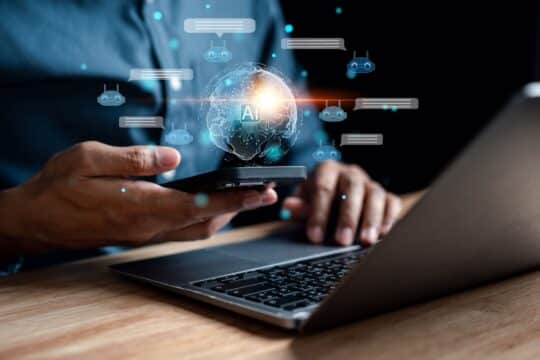As an educator, you may have mixed feelings regarding education buzzwords and trends, embracing them with enthusiasm and caution. While some new trends can make your job easier, others may come across as demands from higher-ups who may not grasp the realities of daily classroom life. Yet, as these new terms and concepts influence our teaching and learning, understanding these buzzwords and their meanings not only is pivotal when engaging among educators but can also help us understand new trends and innovations.
Artificial Intelligence (AI) in Education
Artificial intelligence, or AI, involves machines behaving like humans. It includes using algorithms to help computers figure out solutions to solve problems. Essentially, computers are programmed to think and act like humans. The adoption of AI in education has seen a significant acceleration in the past few years. Teachers use AI-powered platforms like ChatGPT to personalize learning, analyze student data, automate tasks, and make learning more interactive.
Gamification
Gamification, a popular buzzword, refers to integrating gaming elements and their principles into the learning environment. Game elements such as scoring points, receiving badges, leveling up, and competing against others transform the traditional classroom experience by engaging students into an immersive experience. Platforms like Kahoot and Quizlet gamify students’ learning by creating interactive games and quizzes to keep students engaged.
Soft Skills
Soft skills refer to the interpersonal and intrapersonal abilities that help students navigate their way through their environment. These include communicating and collaborating with others, problem-solving, thinking outside of the box, managing their time, adapting and being flexible, and having a work ethic. Developing these skills is crucial to prepare students for academic and beyond success.
Social Emotional Learning (SEL)
Social-emotional learning goes beyond academics and refers to the development of students’ emotional intelligence as well as their interpersonal skills. It involves teaching five key skills: self-awareness, social awareness, self-management, relationship skills, and responsible decision-making. This approach aims to help students understand and manage their emotions. By nurturing students’ social and emotional growth, students will better understand themselves and those around them.
STEAM Education
STEAM, refers to Science, Technology, Engineering, Arts, and Mathematics, is an extension of STEM, a term you may be familiar with. However, STEAM includes the arts, such as fine arts, drama, music, visual arts, and language arts. This approach connects STEM subjects with the addition of the arts to foster creativity and innovation in students. Educators interweave STEAM subjects into their curriculum by encouraging creativity and problem-solving through project-based learning and various collaboration disciplines among students. This approach is meant to prepare students for their future careers.
Personalized Learning
Personalized learning pertains to tailoring individual preferences to meet the needs of students’ unique skills, abilities, interests, and learning styles. This approach uses technology through learning management systems, data analytics, multimedia content, AI, or adaptive learning software like Dreambox learning, which is a K-8 mathematics platform to customize learning. This approach is student-centered, which means students are the center focus and are encouraged to participate and be responsible for their learning actively. Students are also encouraged to work at their own pace according to their specific unique learning styles.
Microlearning
Microlearning is something you most likely already do in your classroom. It involves breaking down information into smaller chunks, making it easier for students to understand. These shorter microlessons usually last about five minutes and focus on one specific concept or skill. This approach caters to students with shorter attention spans which can help them remember information better. Additionally, microlearning mimics what students see on social media, grabbing their attention for short periods.
Asynchronous Learning
Asynchronous learning pertains to an educational model where students learn at their own pace and on their own schedule rather than in a synchronous (real-time) traditional classroom where all students work simultaneously to complete assignments. This approach is common with online education. It emphasizes self-paced learning, where students complete assignments on their own time. This approach is also flexible and accessible, catering to each student’s learning style as well as their lifestyle, making it a creative learning experience for students.
Hybrid Learning
Hybrid learning refers to the combination of in-person learning and online instruction. It gained popularity during the pandemic when face-to-face instruction became more challenging. Students benefited from this blend during the pandemic because of its flexibility and accessibility of online resources. Hybrid learning offers students a learning experience where they can work at their own pace and time while still having in-person sessions and social interaction. This format can accommodate diverse learning styles and can be helpful when in-person attendance cannot be attained.
Culturally Responsive Teaching (CRT)
Culturally responsive teaching (CRT) recognizes students’ cultural backgrounds within the learning environment. The curriculum is designed to integrate students’ diverse cultures by incorporating them into the educational process. For example, teachers can build on the knowledge that students bring to the classroom, such as drawing parallels from what students are learning with a student’s own culture to help explain ideas or concepts. This approach fosters a deeper understanding and enriches the student’s learning environment.
Understanding these buzzwords and their meanings is crucial because it keeps you up to date on the latest trends, methodologies, innovations, and technologies in education. By familiarizing yourself with these terms, you can join in conversations with colleagues more easily, make smarter, more informed decisions, and play a role in shaping the future of education.




